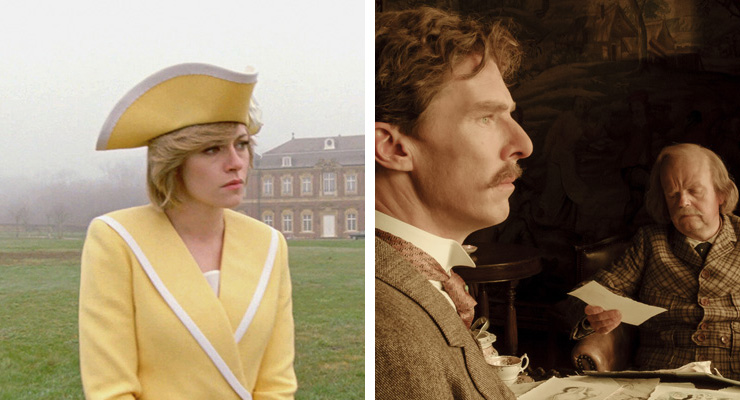
The morning bell has rung on the 2021 awards season. You might as well call it biopic season.
The film biography draws a certain sector of moviedom like bees to honey. You know, those self-described movie buffs who say they support cinema but opt to stay home when the kind of prestige release they would like to see more of opens in theaters. Meanwhile, another sector thumbs their noses at the temerity of filmmakers who aim to encapsulate the essence of one person's life into a multiplex-friendly package. Don't ever whisper the words “based on a true story” to the latter folks. They'll break out in hives.
There are some filmmakers who want to do something fresh and novel with this dog-eared awards magnet of a subgenre, the better to highlight what makes their chosen subject stand out. They take measures to break free from the constrictions that too often entrap portrayals of famous people within the boundaries of conventionality. They frown on safety nets, a tidy adherence to the status quo. When this approach works, you get bold visions that may not always meet with critical consensus but nevertheless manage to capture viewers' imaginations. Even better, they force you to view an individual you thought you had figured out in a completely different light.
But probably more often than not, these gallant efforts go kersplat, done in by a perfect storm of noble intentions and creative miscalculations. They get points for trying something new and adventurous, of course, even as sitting through these faulty efforts becomes an endurance test, made all the more trying by the knowledge that your patience will not be rewarded in the end. Still, you feel like a heel for disliking these films, because they're made by the “good guys.”
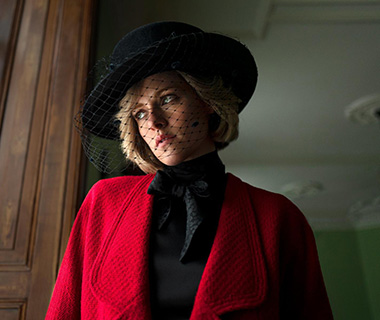
Kristen Stewart in a scene from "Spencer." Courtesy of NEON.
Two new biopics fall under this “noble failure” umbrella. They focus on English figures, one a beloved icon with a fraught and complicated relationship with her royal in-laws, the other a lesser known illustrator and painter with a distinctly feline motif to his work. Both went through periods of mental anguish, and both had lives that clamor for the movie treatment. Let's take a closer look.
“Spencer”: The latest portrait of a woman on fire from Chilean director Pablo Larraín opens with flurry of pageantry, only there's something cold and clinical about it. It's Christmas Eve 1991, and the staff running Queen Elizabeth's Sandringham Estate are preparing for a stay worthy of the Windsors. Fine dining, churchgoing, the annual family portrait and a pheasant hunt are all penciled in on the schedule.
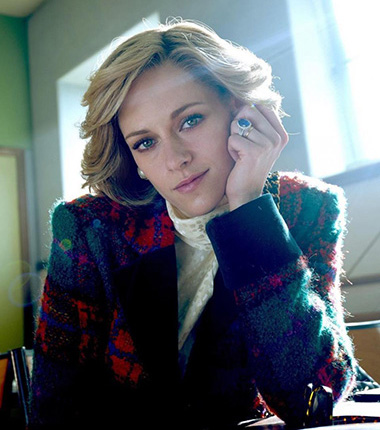
Kristen Stewart in a scene from "Spencer." Courtesy of NEON.
But as Her Majesty nears, a member of the royal family is nowhere to be seen. Princess Diana, you see, is adrift without a compass, in more ways than one. Lady Di has decided to drive herself, and she has managed to get lost, despite having grown up within walking distance of the property. It's safe to say she has a lot on her mind.
This is all most irregular. Doesn't she know no one arrives at Sandringham after the queen? Those in charge of ensuring these holidays go off without a hitch don't say it out loud, but their disapproval speaks louder than words. The stage is set for a showdown: three days of withering glances, hushed gossip from the help, emotional turmoil that manifests itself in an eating disorder, and an agonizing decision with the potential to rock this house to its very core.
The first 20 minutes of “Spencer” lay the groundwork -- physical and emotional -- for the introspective journey that follows with Kubrickian precision. This is no celebration of the rituals that give these royals a sense of identity but a dissection of them. Shooting on film, cinematographer Claire Mathon enhances the petri dish nature of Larraín's approach with long shots of exteriors, including a stunning overhead shot early on, and a mix of static and handheld interior shots that feel as if they were filmed with available light. The gaze is unblinking and somber, and it feels like a good fit for the material.
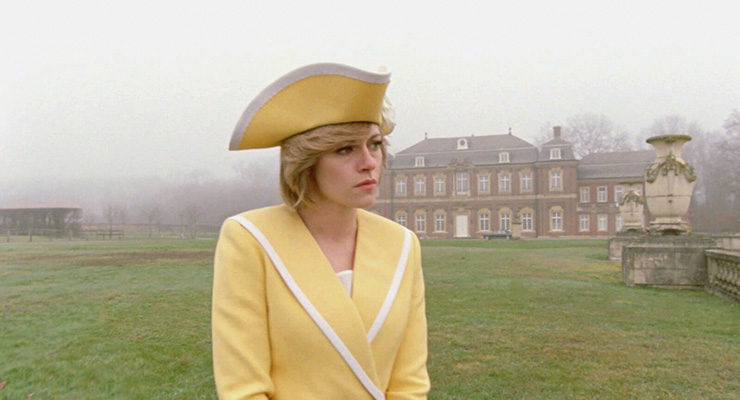
Kristen Stewart in a scene from "Spencer." Courtesy of NEON.
But once Diana sets foot inside Sandringham and, as expected, the viewer is held captive along with her, a curious thing starts to happens. A disparity becomes increasingly apparent between how Larraín stages the contempt and hostility the princess encounters and how screenwriter Steven Knight (“Eastern Promises,” “Locke”) handles it. Characters are prone to recite lengthy monologues about how they view the world and their place in it, while Larraín keeps hitting the same note of despair over and over again. Instead of shining a light on the Princess of Wales' torment, the movie winds up shutting us out.
To make matters even stranger, Larraín and Knight add an element of magic realism that's even more are odds with their dissonant melding of creative forces. In between avoiding dinner appearances, wearing the wrong piece of wardrobe to public events, and straining to keep it together overall as she contemplates leaving her husband, Diana begins to have ghostly visions of Anne Boleyn. It's ostensibly meant to underscore her status as an outsider, but it's just one in a series of jarring flourishes that make the film even more of a chore.

Kristen Stewart in a scene from "Spencer." Courtesy of NEON.
Larraín creates a sense of decay and rot, and it's up to star Kristen Stewart to guide us through this muck. She puts up a valiant effort. It's clear the versatile star, unfairly dismissed as a stiff due to her work in the “Twilight” movies, is doing the best she can, and she certainly looks the part, but her breathy, clipped line delivery is almost as distracting as Larraín's formal experimentation. Yes, she nails the accent, but you end up thinking about that rather than losing yourself in the story. Her performance is too studied; you see the wheels spinning in the actor's head. It doesn't help matters that Jack Farthing, whom you might recognize from PBS' “Poldark,” looks nothing like Prince Charles and is a bit of a blank in the role.
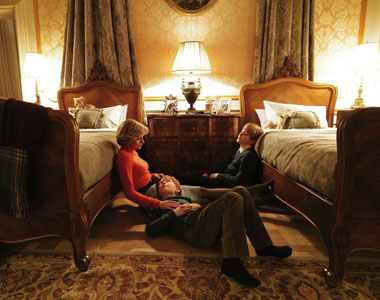
Kristen Stewart, Freddie Spry and Jack Nielen in a scene from "Spencer." Courtesy of NEON.
“Spencer” is a deconstruction of the British stiff upper lip that itself could use more of a sense of humor. It's a brittle biscuit, “Downtown Abbey” on downers. There is light at the end of the tunnel: the film's third act injects some juice into the proceedings, thanks in large part to Sally Hawkins, who imbues Maggie, Diana's favorite dresser, with a spark that is essentially absent elsewhere. There's also a clever use of Mike + the Mechanics' “All I Need Is a Miracle” that helps breathe some life into this crusty affair.
Alas, it's too little, too late. Larraín has been down this road before, back in 2016 with “Jackie,” but that film was a riveting showcase for star Natalie Portman, bolstered by an insightful screenplay and Larraín's stronger grip on the subject matter, in this case Jacqueline Kennedy's struggles in the aftermath of JFK's shooting. With this movie on the director's résumé, there is no reason “Spencer” should feel like taking your medicine, but it does. We end up suffering along with Diana, not as part of the film's design, but because how dreary the darn thing is. RSVP “no” to this tiresome pressure cooker of a character study. Its fragility is of the off-putting kind.
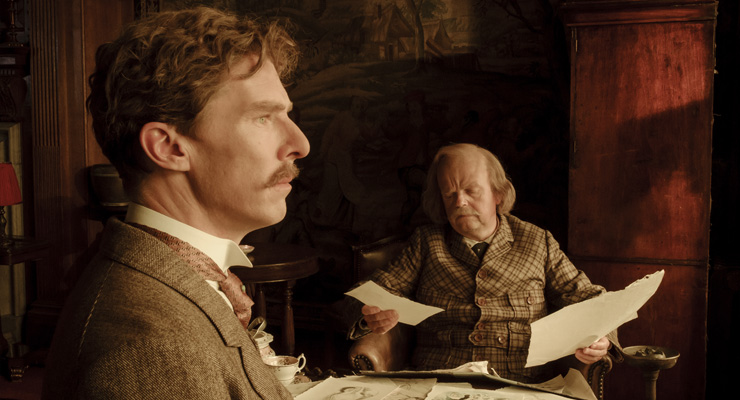
Benedict Cumberbatch and Toby Jones in a scene from "The Electrical Life of Louis Wain." Courtesy of Amazon Studios.
“The Electrical Life of Louis Wain”: You may not know his name, but you've likely seen his kitties. He helped make England a brighter space with his paintings of cats, or in longtime fan H.G. Wells' words, “happier and cattier.” Louis Wain's art ran the gamut from the whimsical to the psychedelic, and my hope for the biopic was that it would approximate that colorful palette.
But director Will Sharpe's erratic portrait is neither here nor there, too self-consciously wacky to be much fun at first, then too much of a slog when it goes all in on Wain's struggles with mental illness. Like Mama Bear and Papa Bear's porridges, it's either too hot or too cold.
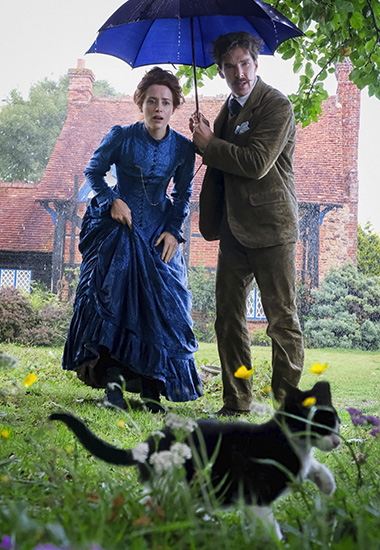
Claire Foy and Benedict Cumberbatch in a scene from "The Electrical Life of Louis Wain." Courtesy of Amazon Studios.
You certainly can't blame the cast. Just check out the big names attached to this Amazon Studios release. Benedict Cumberbatch is a casting bull's-eye as the troubled, brilliant illustrator who embraced his eccentricities and made people look at cats in an entirely different way because of it. (They had been widely regarded as only good for catching mice before Wain made them appealing as viable pets.) “The Crown's” Claire Foy matches him step by step as Emily Richardson, the love of his life and muse, long after her untimely death. The film spans nearly six decades, from Wain's early days as a freelance artist — covering his bumbling, awkward courtship of Richardson, who was employed as his younger sisters' governess — to just before his death in the late 1930s.
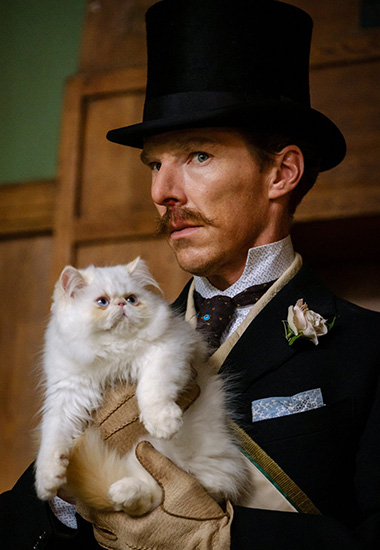
Benedict Cumberbatch in a scene from "The Electrical Life of David Wain." Courtesy of Amazon Studios.
Sharpe, working from a screenplay credited to him and Simon Stephenson, inserts fascinating details about Wain, such as how he uses two pencils simultaneously to etch photorealistic drawings of his subjects, or his lifelong obsession with electricity and the way it dovetails into a nonlinear view of time itself, a view that was way ahead of, well, his time.
All too often, though, “Electrical Life” gets bogged down in dysfunctional family matters, such as the downright combative relationship Wain had with his sister Caroline (Andrea Riseborough), as well as how his sanity began to unravel, all frequently accompanied by Olivia Colman's pedestrian narration. The results somewhat mirror the schizophrenia Wain was alleged to have suffered from. Sharpe goes the “Finding Neverland” route, aiming for the tear ducts when he should have zeroed in more on the artist's inspirations and creative process.
To be fair, “Electrical Life” is occasionally engaging on a surface level. Cinematographer Erik Anderson Wilson, who shot both “Paddington” movies, makes good use of the Academy aspect ratio. The boxy compositions allow for some pretty painterly images. And the score by Arthur Sharpe, the director's brother, makes effective use of the theremin, even though it's a bit on the nose. Perhaps its best asset is Toby Jones, who, as Wain's editor at the Illustrated London News, gives sage advice and has some of the film's best lines. And H.G. Wells makes an appearance, played by musician Nick Cave.
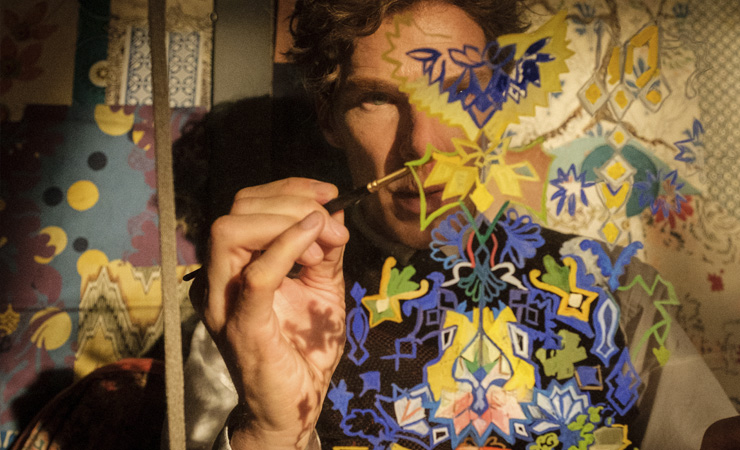
Benedict Cumberbatch in a scene from "The Electrical Life of Louis Wain." Courtesy of Amazon Studios.
The film's willingness to break the tea-and-crumpets mold suggests what a filmmaker like Terry Gilliam could have done with Wain's story, but scratch beneath the surface, and what you're left with is just another middling biopic that's been smothered by its zig-zagging mood swings. The film ends with a glance at some of Wain's better known creations, and the delightful images almost feel like a slap in the face. Where was that magic touch during the rest of the film? It's in scant supply in this portrait of a pioneer that mostly elicits hisses, not purrs.
“Spencer” is now showing in theaters across South Florida, including Regal South Beach, Silverspot Cinema in downtown Miami, the Tower Theater in Little Havana and Gateway Cinema in Fort Lauderdale. “The Electrical Life of Louis Wain” zaps into your flatscreen, laptop or tablet on Amazon Prime Video.




